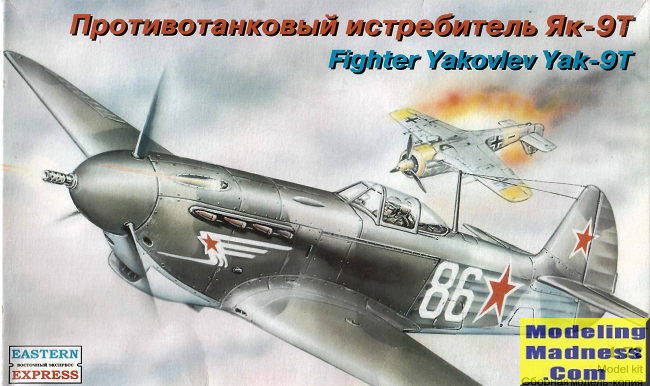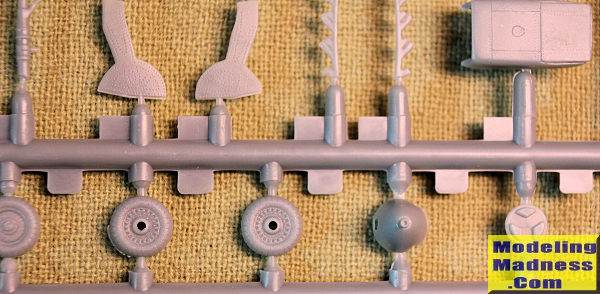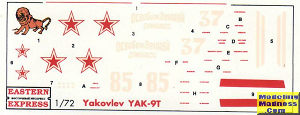
Eastern Express 1/72 Yak-9T
| KIT #: | 72227 |
| PRICE: | $8.00 'used' |
| DECALS: | Two options |
| REVIEWER: | Tom Hall |
| NOTES: | Reboxed Dako kit |

| HISTORY |
In comparison to the Yak-9D, the cockpit was 40 cm farther aft, ostensibly to compensate for the weight of the 37 mm cannon, but we must wonder what happened to the fore/aft center of gravity when lighter armament replaced that cannon. The 9T was powered by the Klimov VK-105PF engine equipped with a VISh-105SV propeller.
A total of 2,748 Yak-9Ts were built, all by Factory Number 153 at Novosibirsk, from March 1943 until June 1945.
| THE KIT |
This kit is a reissue of Dakoplast number 12004 (ca. 1997). The kit was next released under the Eastern Express label, but with different instructions and decals than the Dako version, maybe around 2007. After that, it was issued by “Modelist” of the Russian Federation. Under any label, it is scarce as of spring 2021. It is not to be confused with the ICM/Alanger/Encore kit number 1028, which includes two fuselages, one for the Yak-9DD, 9K and 9T.
The box top shows a plane with a muzzle brake on the cannon. That suggests a Yak-9K, a plane of very limited production that had an impractical 45 mm cannon. The 45 mm cannon and muzzle brake are not supplied in the kit, so it was misleading to depict them on the box top. The kit has a gun molded into the spinner. It has been molded with a little bit of bore, but no muzzle brake.
 More identity crisis is found in
the instructions, which in profiles 2 and 3 go off course to illustrate a
Yak-9DD (a variant with extra fuel capacity) and a 9K. Also, the instructions
show assembly stages 1, 2, 3, 4, 5, and 7, but no 6! (Eastern Express edited
Dakoplast’s instructions.)
More identity crisis is found in
the instructions, which in profiles 2 and 3 go off course to illustrate a
Yak-9DD (a variant with extra fuel capacity) and a 9K. Also, the instructions
show assembly stages 1, 2, 3, 4, 5, and 7, but no 6! (Eastern Express edited
Dakoplast’s instructions.)
The Eastern Express instructions illustrate the earlier Dakoplast decals, but they were not provided in my kit. Do not expect to find the decals to make the plane on the box top! Because the instructions are useless for choosing and positioning the decals that Easter Express did provide, the modeler must guess about those things, including what to do with over a dozen tiny red stenciled warnings and labels. In addition, the white ink has turned beige.
(It is probably possible to make a Yak-9M by modifying this kit slightly. The 9M had a 20 mm ShVAK at the prop hub, a canopy section that could be jettisoned, and improvement of the engine cooling system, possibly a thermostat for radiator shutters. The 9M was produced from May 1944 to June 1945, concurrently with the 9T at Factory Number 153.)
 Although the molds for this kit
were not the most refined, I like the surface detail on this model. There is
little detail on the wings, true to the wood skin of the aircraft. The cockpit
has tubular framing molded into the sides of the fuselage. Clear parts include
armored glass behind the pilot’s head, a neat gunsight and a three-piece canopy.
Unfortunately, armored glass for the front of the windscreen was omitted. The
clear parts are of surprisingly good quality. There are some odd gouges in the
wheel wells that make no sense for positioning the main landing gear assemblies.
Although the molds for this kit
were not the most refined, I like the surface detail on this model. There is
little detail on the wings, true to the wood skin of the aircraft. The cockpit
has tubular framing molded into the sides of the fuselage. Clear parts include
armored glass behind the pilot’s head, a neat gunsight and a three-piece canopy.
Unfortunately, armored glass for the front of the windscreen was omitted. The
clear parts are of surprisingly good quality. There are some odd gouges in the
wheel wells that make no sense for positioning the main landing gear assemblies.
| CONCLUSIONS |
We don’t have many choices for a “cockpit aft” Yak-9 in 1:72 scale. I like the Dako/Eastern Express product a little better than the ICM/Encore kit of the DD/T/K because of its surface detail. (At the same time, I believe the ICM/Encore kit has its merits, too.)
| REFERENCES |
Aviation of World War Two, http://www.airpages.ru/eng/ru/yak9t.shtml.
Geust, Keskinen and Stenman, Red Stars, Kustantaja, Kangasala, Finland (1993), p. 37.
Green, William, Fighters, Vol. 3, Doubleday & Co., Garden City, NY (1961), ff. 170-172.
May 2021
Copyright ModelingMadness.com. All rights reserved. No reproduction without express permission.
If you would like your product reviewed fairly and fairly quickly, please contact the editor or see other details in the Note to Contributors.